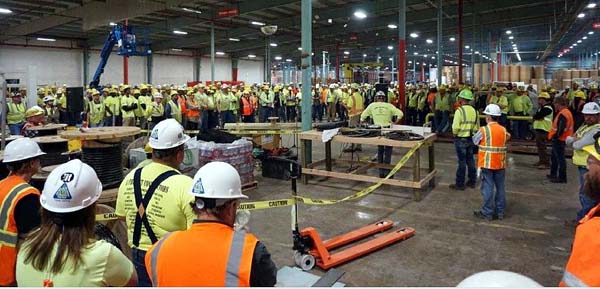
| Archive/Subscribe | TAPPI.org | Advertise | TAPPI Press Catalog | June 2016 |
Domtar Ashdown Mill Set for July 3 Fluff Pulp Conversion Startup
According to a recent feature article by The Texarkana Gazette, Texarkana, Tex., USA, on March 31 the local A64 paper machine at Domtar's (Montreal, Canada) Ashdown, Ark., USA, mill produced its last reel of paper, marking the final day of operation for one machine and setting the stage for a new era and the future of the site.
After employees shut down the machine, the work began with a three-month window to convert and startup the new A1 fluff pulp machine, with the ultimate goal of having the A1 machine to begin producing pulp by July 3.
The conversion and transformation of this machine will demonstrate the strength and fiber of the Domtar employees. The A1 fluff pulp conversion project is the largest capital project in the new Domtar's history. Once online, this new A1 machine will be one of the largest fluff-pulp machines in the world, according to the Domtar A1 fluff project update report.
When the A64 paper machine went down at the conclusion of March, the clock began a 93-day extended outage window to convert the machine to produce fluff pulp, said Tammy Waters, manager of communications and government relations.
 Pictured above: Domtar Mill Manager Bob Grygotis addresses a group of contractors about the importance of safety before work begins on the new fluff pulp machine at the mill in Ashdown.
The demolition of A64 paper machine required the removal of 1,800 tons of steel and 100 tons of copper, said Bob Grygotis, VP and GM of the Ashdown Domtar mill. In addition to the steel and copper, 1,200 cubic yards of concrete has been placed around shores of the effluent treatment ponds.
The demolition was completed and the construction crews are now in the process of building the new A1 machine.
"We physically had to dig some holes 40 to 50 feet deep to prepare for the new equipment... We've had up to 500 people inside of the building working at one time to help with the transformation. We've had a pretty steady drum beat of this pace going through the mill," said Grygotis.
Employees assigned to the A1 machine began an extensive two-month training process starting April 5. A motivational speaker was used to kick off the training process, which was very extensive in subject matter and methods.
"Enthusiasm quickly built among the team as they realized the significance of their role with the new beginning at Ashdown," Grygotis added.
"It's not just about buying the equipment and installing it. We're setting up the system. We've had to design a warehouse originally made for paper to pulp and plan the outbound shipments. We will probably have more shipments by rail than in the past. The rail shipments will be pretty substantial," he said.
The research to construct the paper machine and to determine the equipment needed resulted in employees going to Europe and Finland to inspect in detail prior to shipment. Final plans were announced in December 2014 to invest $160 million to permanently convert one of the Ashdown mill's three paper machines to produce up to 516,000 metric tpy of premium fluff pulp.
Fluff pulp is the material used in absorbent products such as baby diapers, feminine hygiene, and adult incontinence products and market/bale pulp is the product used to make various paper products.
"Domtar is also investing in a pulp bale line to give the mill the agility to manufacture paper-grade softwood bales, depending on market conditions... It's definitely a step forward, certainly with the decline in paper consumption across the U.S. and North America. Fluff pulp will make our company a global leader in a growing market," Grygotis explained.
The fiber in pine trees, he said, resembles the fiber of cotton, but without all of the negative attributes for growing cotton such as pesticides. He said with this project Domtar intends to reach "a worldwide footprint" in manufacturing fluff pulp created by using the pine tree fiber. Domtar is preparing the A1 machine to create the product with quality.
"Ensuring quality for key customers is a top priority. The A1 team has observed factory performance tests to ensure the equipment meets high standards. The laboratory area is being remodeled with the addition of state-of-the-art equipment," Grygotis said.
The quality team also is working with the Plymouth, N.C., mill to ensure the mill's quality program and system will exceed pulp customers' expectation, he noted. The Ashdown paper mill has a history of being innovative and pragmatic in such endeavors.
The ambitious history of building and later expanding the mill goes back to 1966. According to the Gazette:
In that year, the only sign a new paper mill was going to be built south of Ashdown, Ark., in a 2,000-acre clearing along U.S.. Highway 71, was just that—a sign. A year earlier, Nekoosa-Edwards Paper Co. (later Nekoosa Papers Inc.) owners decided to build a new paper mill, but the site had not been selected.
Several sites were considered in the South, but Arkansas finally was chosen because of unique, advantageous forest access. The U.S. Army Corps of Engineers happened to have completed work on a new reservoir for flood control measure in Little River County. The combination of the new reservoir, which could supply adequate water to a new mill, and the abundance of nearby wooded land, was enough to entice Nekoosa to build a pulp and paper mill. Little River County residents, eager for the new employment, approved a $50 million bond to fund the initial investment for the mill.
After the 1966 groundbreaking ceremony and two years of planning and construction, the Ashdown mill began operation July 17, 1968, with 450 employees and one paper machine, named "The Communicator."
In 1970, the Great Northern Paper Co., and the Nekoosa-Edwards Paper Co. merged to create Great Northern Nekoosa Corp. After several expansions, Great Northern Nekoosa Corp., approved funding for the fourth major expansion of the Ashdown mill on Jan. 4, 1989, according to local news archives The $500 million-plus expansion began in mid-1989, featuring the world's largest fine paper machine, capable of producing more than 900 tpd, increasing production by 67%.
On Mar. 6, 1990, the mill officially became Georgia-Pacific Corp., Ashdown Operation. Domtar purchased the mill on Aug. 4, 2001. With Domtar now the established owner of the veteran mill for nearly consecutive 15 years, theGazette reports that the Ashdown site is continuing to thrive and provide quality products worldwide.
|


